Exhibition ‘Seas and Oceans’: a collaboration between artists and scientists
From April 21 to June 25, 2023, the ‘Seas and Oceans’ exhibition will be held at Talk C.E.C., located in the former Demeuldre buildings in Brussels (Ixelles). Several researchers of the Royal Observatory of Belgium have collaborated with artists to create immersive works linking art and science.
Mural frescoes, visual and sound experiments, installations, scenic events, lectures… This exhibition aims to raise public awareness of the preservation of seas and oceans through art and culture. It offers a sensory immersion below sea level in order to understand the complexity and the environmental issues through a new perspective.
In particular, the presented works of art are the result of the collaboration of more than 40 artists and 18 scientists. Five of the latter are linked to the Royal Observatory of Belgium and were able to bring their expertise to inspire the artists in their creation.
Each of our scientists interacted with an artist on several occasions. They provided them with data, graphs, diagrams or simply some explanations of their activities related to astronomy, solar physics, planetary sciences and seismology. The artists with whom they collaborate are inspired and, according to their speciality and sensitivity, create an original work of art.
In parallel to the exhibition, the scientists will participate in science cafés and lectures where they will talk about their research in relation to the artworks. The lectures and science cafés are free for the public.
The turbulence of the Sun in a mural piece
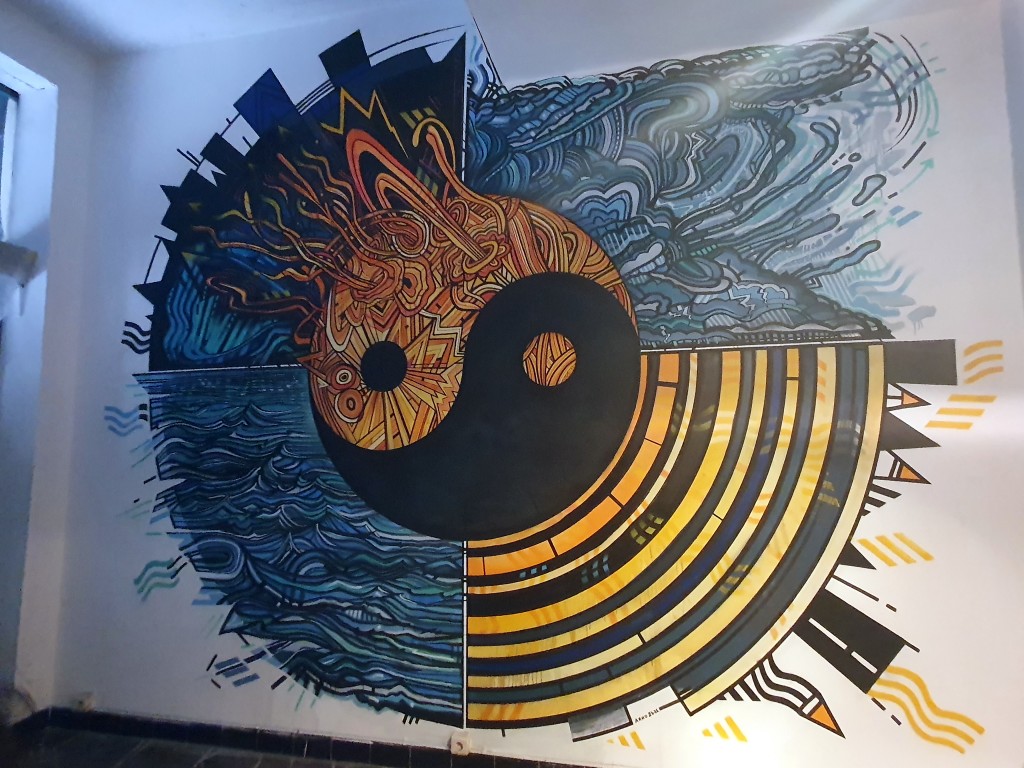
Part of a mural painted by Arno2bal, representing the Sun and its activity. Credit: Karolien Lefever.
The Sun, our nearest star, has a crucial influence on the existence of life on Earth. Without the Sun, there would be no liquid water on our planet. Frédéric Clette, a solar physicist at the Observatory, gave the artist Arno2bal a summary of scientific knowledge about the Sun and its relationship with the Earth, using images and sketches. Arno2bal was inspired by this and condensed all these notions into a large mural. The Sun, its magnetic structures and the rays it emits can be seen in a large circular symmetry. A division into four quadrants centred on the yin and yang symbol contrasts the benefits and threats that the Sun represents today for the survival of humanity on Earth, a contrast also evoked by a calm sea, where an aurora borealis is subtly reflected, and a stormy sky, thus completing the link with the oceans.
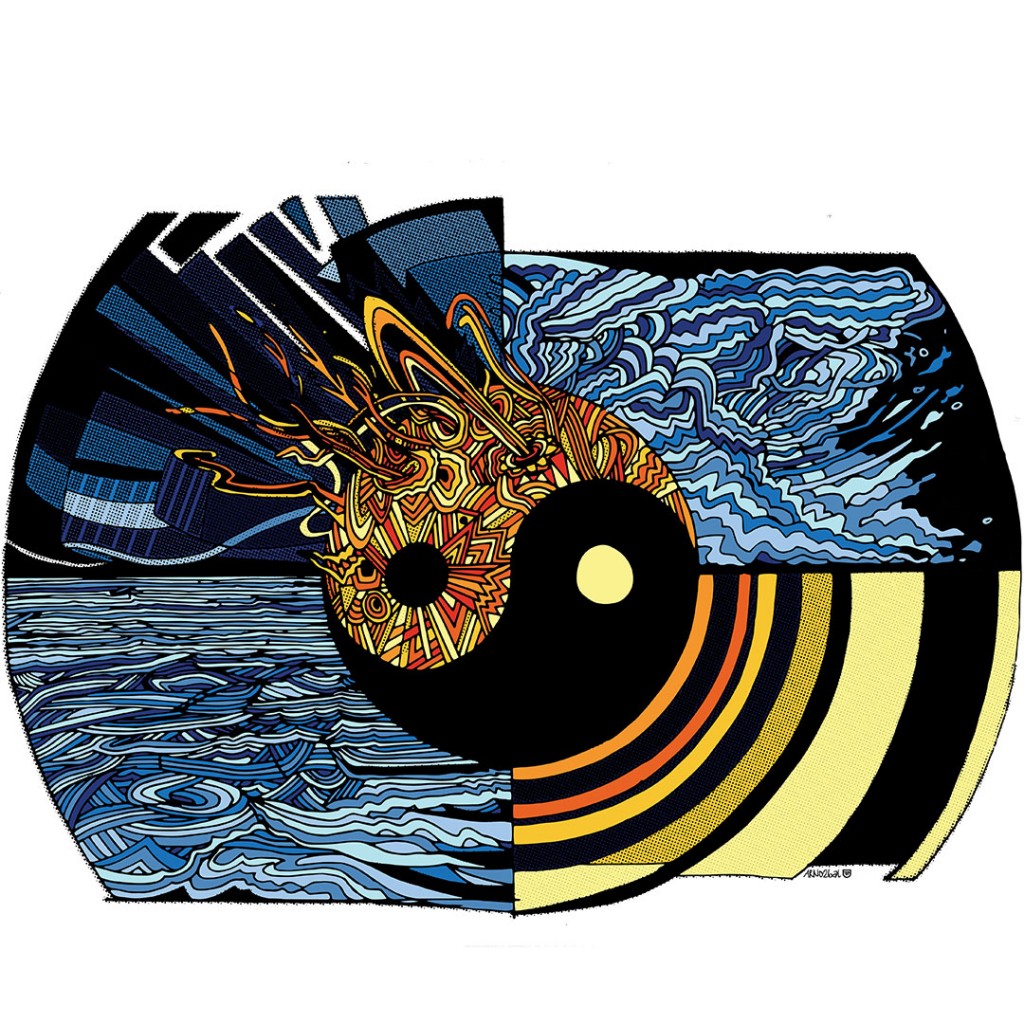 Sketch of the Sun fresco painted by Arno2bal. Credit: Arno2bal Sketch of the Sun fresco painted by Arno2bal. Credit: Arno2bal |
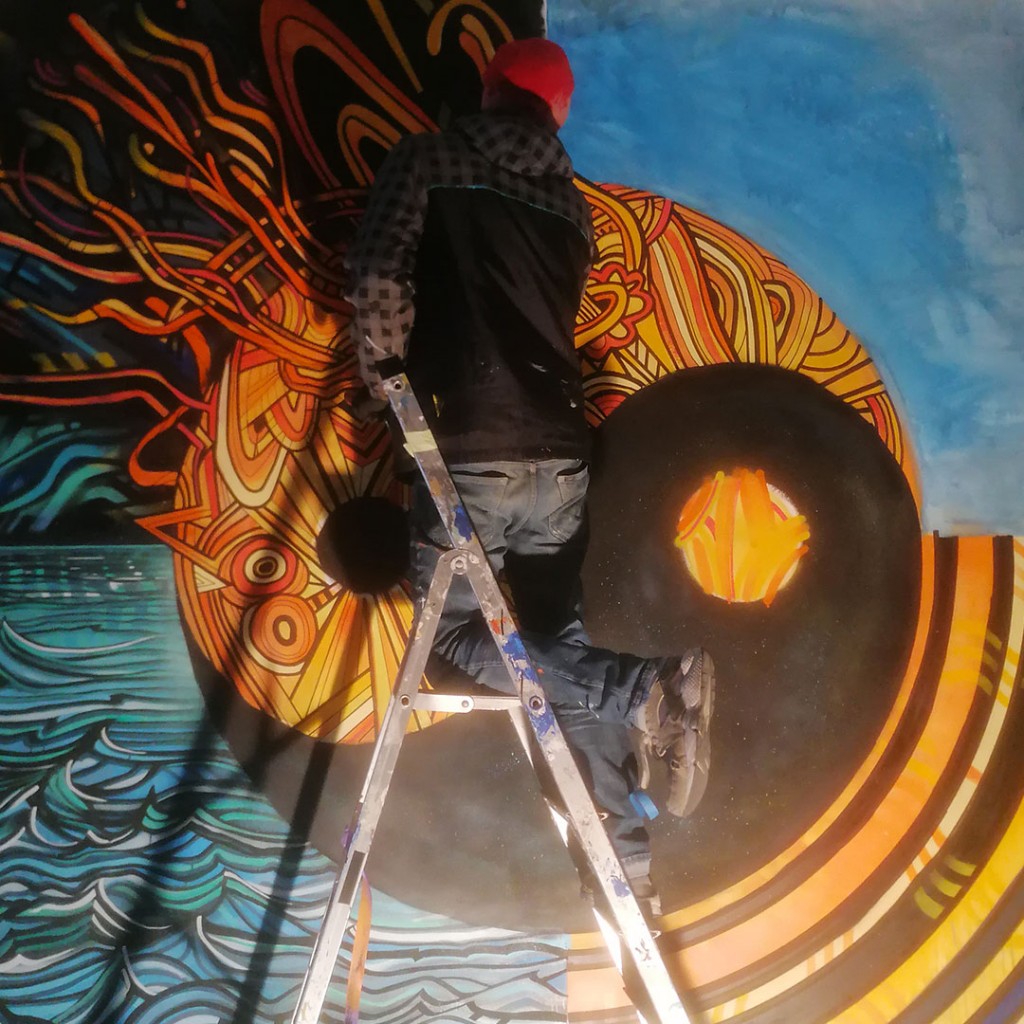 Arno2bal painting the mural fresco featuring the Sun. Credit: Arno2bal Arno2bal painting the mural fresco featuring the Sun. Credit: Arno2bal |
A visual installation to interact with seismic waves
The Observatory has expertise in Earth sciences, in particular the study of deformations and vibrations of the Earth’s crust, and two researchers specialised in this field have inspired the creations of two artists with their knowledge.
Michel Van Camp, former head of the seismology-gravimetry department at the Observatory and now General Director of the Royal Belgian Institute of Natural Sciences, explained to the artist Ruben Voka the links between vertical ground movements and mean sea level. This enabled him to create a representation of tectonic plates on the ground to illustrate the rise in sea levels due to climate change.
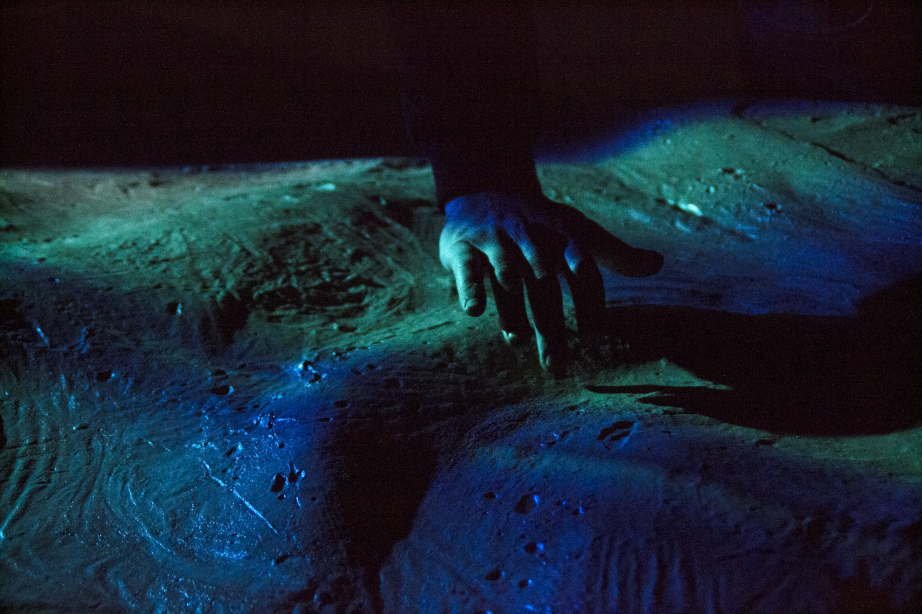 |
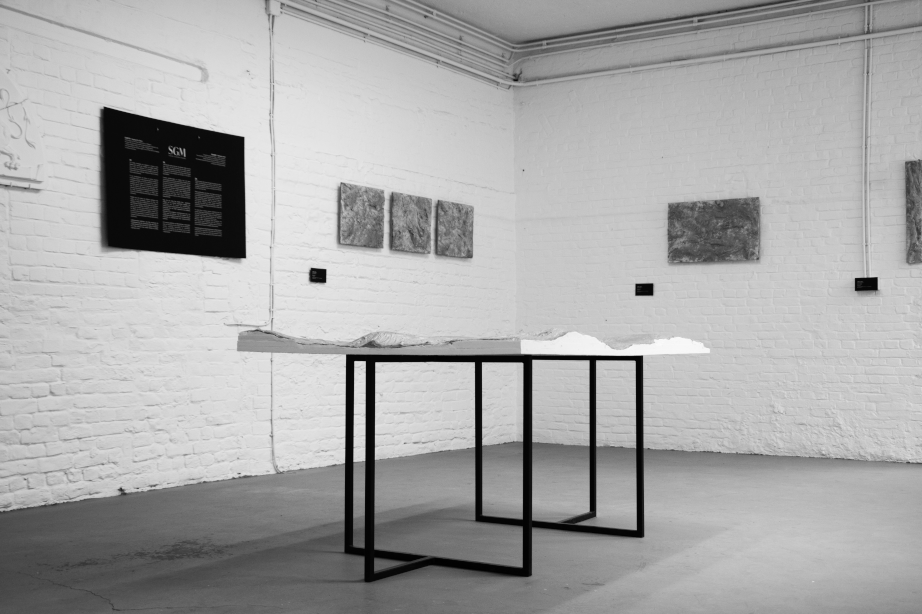 |
| Photos of Thiébaut Grivel’s ‘Seismic waves’ installation built with the scientific advice of Raphael De Plaen of the Royal Observatory of Belgium. Credit: Thiébaut Grivel. | |
Artist Thiébaut Grivel, who collaborates with Raphael De Plaen, seismologist at the Observatory, seeks to make visible what is inaudible by giving a material texture to his works. His three-module installation was created using seismic wave data generated by the oceans and recorded by seismic stations around the world. The visitor can play with these seismic waves on a plaster sculpture of the ocean floor, onto which the energy of the ocean waves is projected. In this way, they will also be able to understand the relationship between the oceans and seismic waves, which in the past were considered as a noise, but which have become useful ‘music’ for current seismic research.
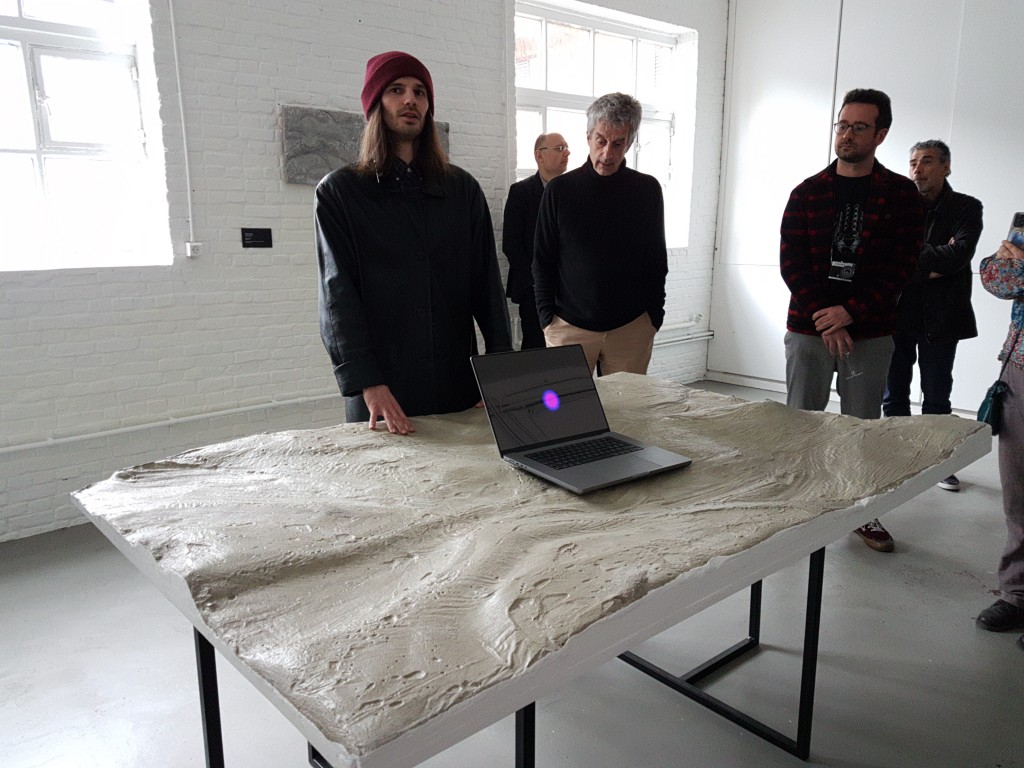
Artist Thiébaut Grivel presenting his art installation at the preview of the exhibition Seas and Oceans.
Paintings linking the stars to the fragility of our oceans
The arts and sciences have different objectives, approaches and methods, but both have the world as their object and help to increase our knowledge, perception and awareness of it. In the context of the ‘Seas and Oceans’ exhibition, they raise awareness of our environment and the need to protect it.
What would the Earth be without its oceans? Together with Orkun Temel, a researcher in planetary sciences at the Observatory, the artist Mister Copy painted a mural showing a civilisation in a world without ocean like Mars and Venus. Astrophysicist Thibault Merle of the Observatory collaborated with artist Laura Johnson for his painting of an iceberg under a starry night, linking the oceans and the stars.

Part of Laura Johnson’s work, ‘Exo-Worlds and Water’. Oil painting on canvas, 100cm x 100cm. Credit: Laura Johnson.
The connection between science and art is something that Thibault Merle has long would like to deepen. ‘The Seas and Oceans exhibition makes sense to me,’ he says, ‘because it tries to draw attention to the fragility and delicateness of the Earth’s biosphere. As an astrophysicist, I know very well that we don’t have a Planet B, despite the recent discoveries of many terrestrial exoplanets that will remain inaccessible for centuries under our current theories of space and time. That is why it is so important to preserve it, and in particular the oceans that cover 2/3 of the Earth surface.’
Information
Dates: from Friday 21 April 2023 to Sunday 25 June 2023
Opening hours: Friday to Sunday from 12:00 to 18:00 (last entry at 17:00)
- Guided tours during the day: at 12:30 and 14:30 from Friday to Sunday
- Guided tours during the evening: at 18:30 and 19:30 on Fridays and Saturdays
Location: Talk C.E.C. Maison Demeuldre, Chaussée de Wavre 143 – 1050 Ixelles
Accessibility: partially accessible to people with reduced mobility (only the ground floor)
Ticketing and booking: https://feverup.com/m/128173
The scientists involved and the dates of their presentations
The lectures and science cafés will take place at Talk C.E.C. (Chaussée de Wavre 143 – 1050 Ixelles) and are free of charge for the public. The lectures last about one hour. The lectures dates mentioned below are the dates of presentations given in English.
Full conference and science cafes programme: https://talk-cec.com/index.php/conferences/
Frédéric Clette
Work: The Sun and the Origins of the Earth (working title)
Artist: Arno2bal
Frédéric Clette will participate in the following lectures/science cafés:
—April 29 at 14:00 – Lecture: ‘An ocean under the sun: flares, climate, life and energy’.
—June 18 from 15:00 to 18:00 – Science café.
Raphael De Plaen
Work: Seismic waves
Artist: Thiébaut Grivel
On May 14 at 16:00, Raphael de Plaen will give a lecture: ‘Seismic waves: their impact on ocean dynamics’. On the same day, he will present the artwork ‘Seismic waves’ with the artist Thiébaut Grivel.
Thibault Merle
Work: Exo-worlds and water
Artist: Laura Johnson
Thibault Merle will participate in a science café on May 14 from 15:00 to 18:00.
Orkun Temel
Artwork: Water on Mars and Venus
Artist: Mister Copy
On June 16 at 17:00, Orkun Temel will give a lecture: ’Could early Mars and early Venus have had oceans?
Michel Van Camp (worked at the Royal Observatory of Belgium until 14/03/2023)
Work: Tectonic movements and sea levels
Artist: Ruben Voka
On June 4 at 14:00, Michel Van Camp will give a lecture with the artist Ruben Voka entitled ‘Anticipating the rise in sea levels’. He will also participate in a science café on the same day at 15:00 and at 17:00.
